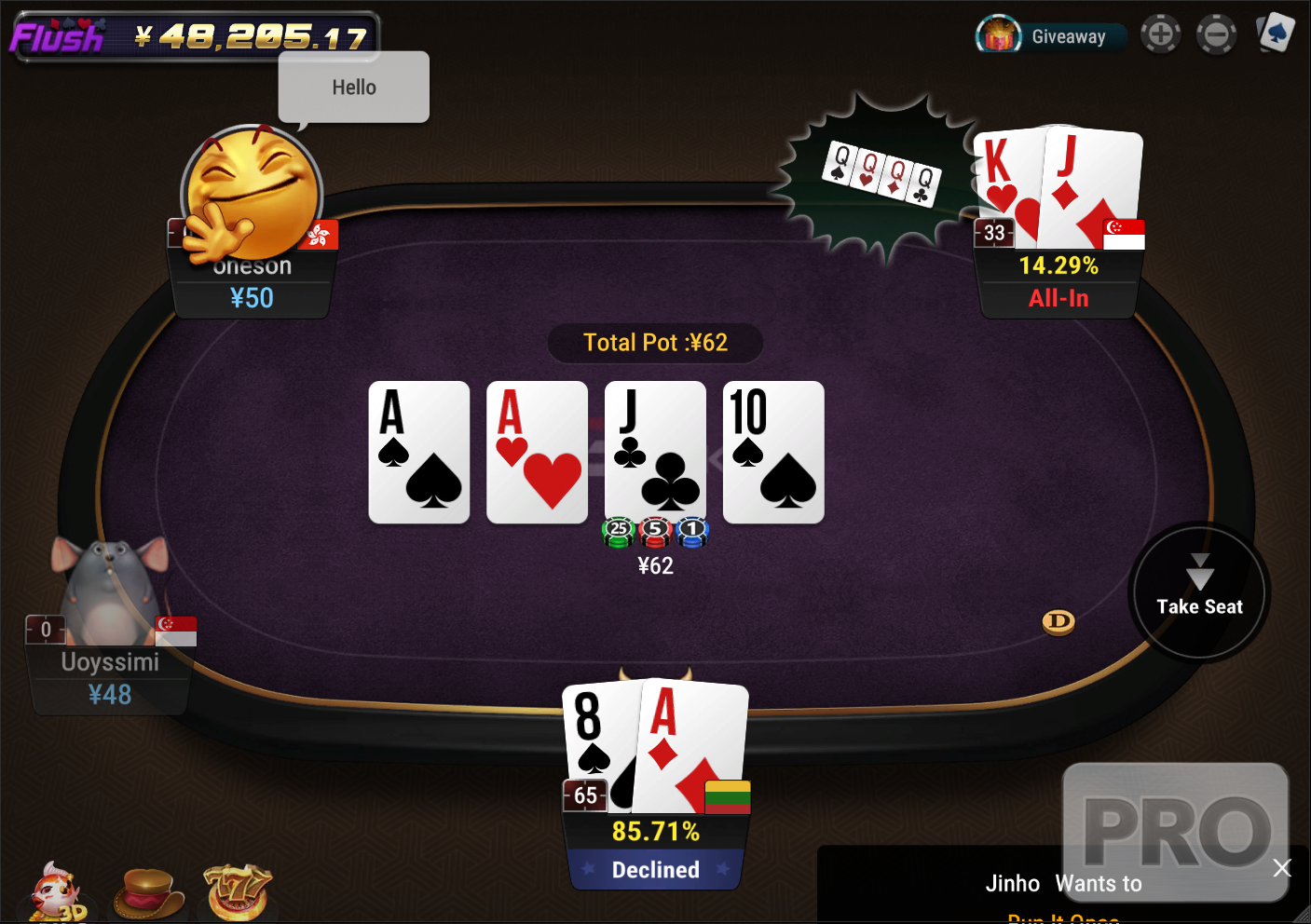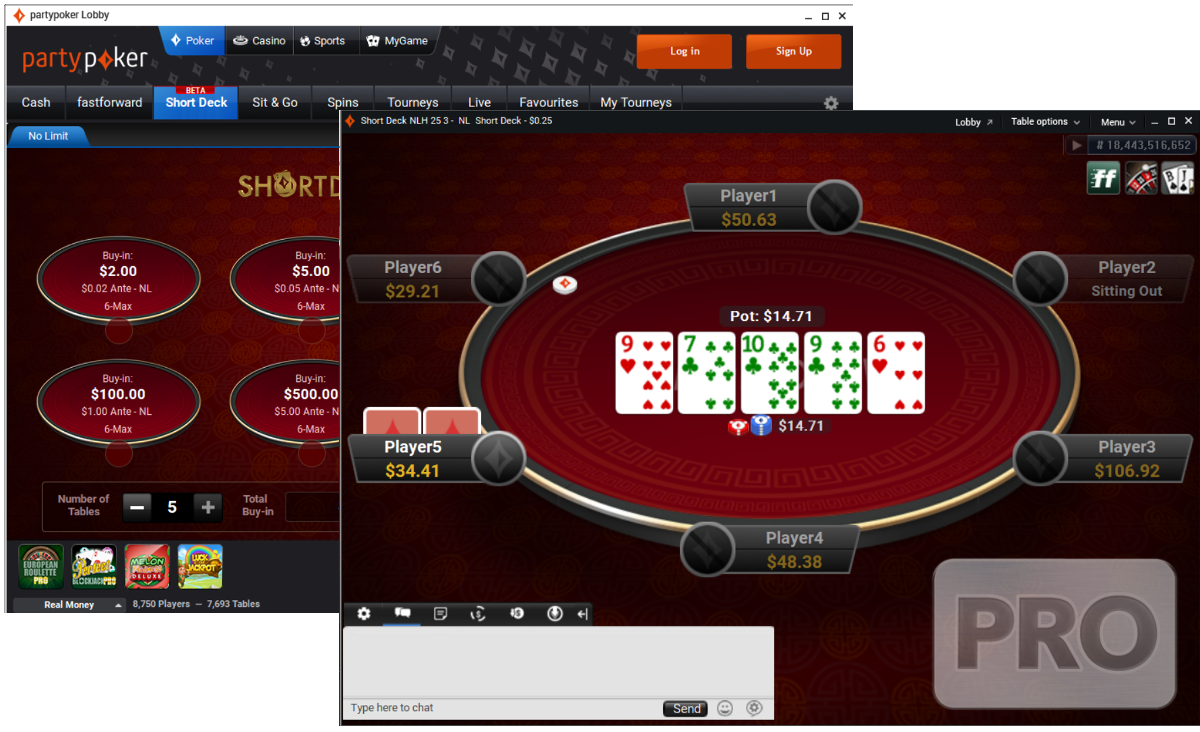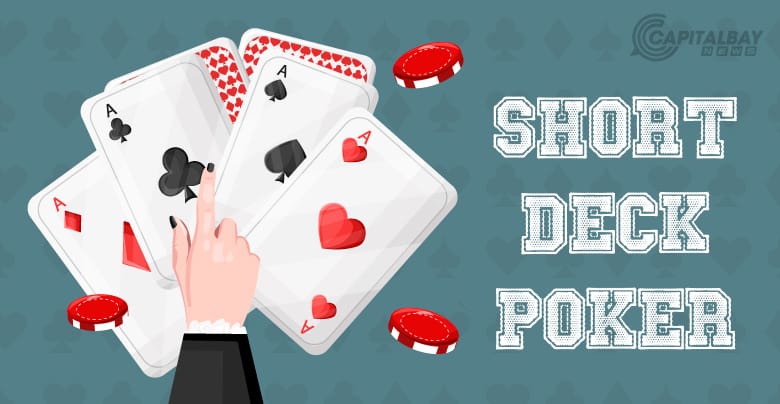Short Deck In Poker
Recently I’ve been hearing about a new game called short deck. It’s played just like normal Texas hold’em, except it’s played with a short deck—all the cards deuce through five are removed from the deck. Aces play as the low end of a nine-high straight. Some variants reorder the hand rankings, most notably changing it so that flushes beat a full house.
Notable Short Deck Rule Adjustments. Short Deck is played with only 36 cards as opposed to 52 because the twos, threes, fours, and fives are removed from the deck. Instead of the traditional small blind and big blind, Short Deck uses a unique ante format (explained in the next bullet). 🔱 The likes of Tom Dwan, Rui Cao, Timofey 'Trueteller' Kuznetsov Tan Xuan, and Mikita Badziakouski sat down for a Short Deck Cash Game session during #Trito.
When I first heard about it, it sounded to me like the new math would break a lot of players’ intuition they’ve built playing regular no-limit hold’em. So the first thing I wanted to do was go through how some of the math changes.

Let’s say you get dealt 10h 9h. Let’s go through the math of how often you flop straight and/or flush draws both for normal hold’em and then for short deck.
Full Deck Draws
Once you have your two cards, 50 cards remain in the deck. Three of these will appear on the flop, so there are 50 choose 3 total possible flops. (You can type 50 choose 3 into Google and it will give you the answer.) In this case, that’s 19,600 possible flops.
To flop a flush draw, you need two of the 11 remaining hearts on the flop, as well as an unrelated third card. So that’s 11 choose 2 times 39 (the number of non-hearts remaining in the deck). Since 11 choose 2 is 55, the total number of flush draw flops is 2,145. Divide that by the total number of flops, and you get about 11 percent, which is how often you will flop a flush draw.
To flop an open-ended straight draw you need either Q-J, J-8, or 8-7 on the flop—in each case also with an unrelated card. There are 16 ways to have Q-J (four queens times four jacks), and 16 ways each for the other two for 48 total ways.
What Is A Short Deck In Poker
If we specify that the unrelated card can’t be one that completes the straight, there are 40 possible unrelated cards for each of the 48 total ways to flop a straight draw. That makes 1,920 total straight draw flops. Divide that by the total number of flops, and you get about 10 percent, which is how often you will flop a straight draw.
Short Deck Draws
In short deck, there are 34 remaining cards after you get your two, so 34 choose 3 or 5,984 possible flops.
There are only 7 remaining hearts, so to flop a flush draw you have 7 choose 2 times 27 possible flops. That’s 567 flops or about 9.5 percent of flops. The full deck chance was 11 percent so flush draws are somewhat less common in short deck.
To flop a straight draw you still have your 48 ways to get Q-J, J-8, or 8-7 on the flop, but now there are only 24 unrelated third cards. That’s 1,152 total straight draw flops or about 19 percent. The chance of flopping a straight draw in short deck is much higher than it is with a full deck.
Making The Draw
Everyone knows the chance to make flush and straight draws in normal hold’em are nine and eight outs respectively. You can use the rule of two and four to estimate the chance of making the draws. But the exact way to figure it out is to do something similar to what we did on the flop. The only twist is you calculate the chance of missing the draw and then subtract that from one.
There are 47 choose 2 possible turn and river cards. That’s 1,081. If you have a flush draw (nine outs) then there are 38 cards that brick your draw, so you have 38 choose 2 ways to miss. That’s 703 total misses out of 1,081, or 65 percent. That leaves a 35 percent chance you hit your flush draw.
Straights work the same, except you have 39 cards that brick your draw. That’s 741 total misses, or 68.5 percent. That leaves a 31.5 percent chance of hitting the draw.
In short deck, there are 31 choose 2 possible turn and river cards. That’s 465. A flush draw has only five outs in this game. So there are 26 cards that brick your draw, and you have 26 choose 2 ways to miss, or 325. That’s about a 70 percent chance to miss, so it’s about a 30 percent chance to make a flush.

Open-ended straights still have 8 outs though. So there are only 23 cards that brick your draw, giving you 23 choose 2 ways to miss, or 253. That’s about a 54.5 percent miss percentage, so you hit your straight about 45.5 percent of the time.
That’s pretty close to 50-50! And you flop a straight draw to your connector nearly 20 percent of the time. Flushes are a bit harder to make in this game, but straights are much easier.
Flopping A Set
The odds of flopping a set change also in short deck. You can figure it out the same way as the chance of making draws—count the flops where you miss the set and subtract from one. With a full deck, there are 48 choose 3 ways to miss your set, or 17,296. That’s about 88 percent of flops, leaving about a 12 percent chance to flop a set.
In short deck, there are 32 choose 3 ways to miss your set, or 4,960 flops. Divide that by the 5,984 total possible short deck flops, and there’s about an 83 percent chance to miss, leaving a 17 percent chance to flop a set.
Final Thoughts
I don’t know how many of us will be playing short deck soon. The game is popular in only a small number of places, mostly in ultra high-stakes cash games. I think one reason it’s become popular in those games is because it turns your ingrained intuitions against you.
When you’ve played hold’em long enough, you begin to internalize the probabilities to make certain hands. You end up getting to the correct answer in many situations through intuition honed over zillions of hands.
Short deck wrecks a lot of those intuitions. The probabilities to make the basic hands are just plain different. Therefore hand values are different. The hands to semi-bluff with and bluff catch with and so on are also different. Blockers mean more in some contexts.

The basic concepts of poker are all the same. But the details of how to resolve conflicts between competing concerns is turned on its head.
Shaking things up in this way always tends to reward the best poker players. The ones who can adjust more quickly than anyone else. The ones who can figure things out rather than rely solely on learned intuition.
Doing the math in this article is the beginning of this process. ♠
Ed’s newest book, The Course: Serious Hold ‘Em Strategy For Smart Players is available now at his website edmillerpoker.com. You can also find original articles and instructional videos by Ed at the training site redchippoker.com.
Table Of Contents
Over the course of the past two-plus months, we've looked over different aspects of short deck hold'em in an attempt to begin and accelerate the learning process in this young game. We've covered the rules, the odds, strategies for both preflop and postflop play, and examined hands played by some of the best players in the world.

Today, we'll wrap up the series with a look at some industry experts' thoughts on the longevity and sustainability of the format in the modern poker scene, particularly through the lens of tournament play.
Leading the Way
While short deck has slowly filtered further into the poker mainstream after originating in highly private, nosebleed-stakes cash games in Asia, there's no question one venue has been a step above the rest in encouraging and nurturing its growth — ARIA.
Not only has ARIA introduced short deck into its high-stakes tournament series Poker Masters and U.S. Poker Open at the PokerGO Studio, but short deck events routinely run in the $200 price range in the main poker room.
To figure out how and why ARIA has been at the forefront of short deck's expansion, PokerNews corresponded with Sam Simmons, president of Poker Central, which runs the made-for-streaming events at the studio.
Simmons says short deck is a natural fit for TV in more than one way.

'Not only is the game exciting with high variance and drastic swings, but short deck events allow PokerGO viewers the opportunity to watch the best poker players in the world attempt to 'solve' this relatively new variant in real time,' Simmons explains.
Short Deck as a Tournament Game
ARIA has reached back into the old school for their tournament structure in the high-stakes events, introducing a 'triple chance' format that gave players three starting stacks with the option to play as many as they wanted at a time. Players could choose to hold one or two stacks in reserve up until the close of registration, at which point they'd automatically come into play.
When the World Series of Pokerannounced a short deck event would be included on the 2019 schedule, they followed this lead with a 30,000 stack and a 30,000 add-on.
In practice, the reasoning would seem to be that because it's frequently correct to get stacks in — recall that equities in short deck are very close — operators don't want players to have a miserable experience of sitting down, getting all in and busting, then reentering over and over.
Isaac Haxton told PokerNews he's a fan of the triple stack, and Simmons says the feedback from the tournaments has been 'immensely positive.'
Haxton says he definitely sees short deck as a viable tournament game. Like Somerville, he equates it to PLO but points out it actually has some advantages.
'It has some things in common with pot-limit Omaha with closer equities leading to weird bubble play,' says Haxton. 'But in contrast to Omaha at least you can go all in, which mitigates some of the really severe punishment that shorter stacks take on the bubble. They can at least put all their chips in the middle rather than open and either get flatted or three-bet and have to play from there.'
Short Deck Going Forward
While Somerville said on a recent appearance on PocketFives' podcast The Fives that he feels short deck is the future of poker, not everyone is so rosy about its outlook.
Kane Kalas, serving as commentator for the Patrik Antonius Poker Challenge, said that because there are fewer cards in the deck, he sees the players who really dive into the game solving it more quickly than no-limit hold'em.
Short Deck Poker Starting Hand Rankings
As a counter to that, Somerville points out that the frequency of multi-way pots makes the game deeper than it at first appears.
Meanwhile Haxton says the biggest issue he's seeing so far is the structure of registration and starting stack depth.
Short Deck Poker Book
'I think that at some point there's going to be a shift towards closing registration earlier in short deck tournaments,' says Haxton. 'I think right now, you can enter and the tournament's in the money an hour later. The late registrants are getting a decent advantage there. I think short deck tournaments are going to shift toward starting deeper and closing registration earlier to mitigate that.'
Simmons says Poker Central remains committed to short deck, and he has high hopes for the game.
'As short deck becomes more mainstream with lower buy-in price points allowing additional players greater access to the game, we expect it to become one of the core variants across the poker calendar at a variety of stakes,' he says. 'We expect the game to be a staple of PokerGO live events for years to come.'
If Simmons and Somerville are right, then short deck will be coming to a card room near you. Maybe sooner, maybe later, but eventually, poker players everywhere may have access to this increasingly popular game.
Hopefully, when that day comes, this 10-part series has helped give you a solid base of knowledge as you begin your own journey in short deck.
Tags
tournament strategyshort deck hold'emsix plus hold'emIsaac HaxtonKane KalasJason SomervilleARIAPokerGOPokerCentraltournament structuresRelated Players
Isaac HaxtonJason SomervilleKane Kalas